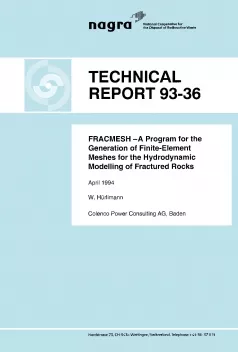
Technical Report NTB 93-36
FRACMESH -A Program for the Generation of Finite-Element Meshes for the Hydrodynamic Modelling of Fractured Rocks
In the field of radioactive waste disposal, the finite-element (FE) approach is commonly used for numerical modeling of fluid flow, solute transport and heat transfer through a geological environment. The principle of these models is the discretisation of 2- or 3-dimensional space into geometric finite elements. In general, these FE grids are generated automatically or semi-automatically by means of "mesh-generators". The principal restrictions that control the generation of numerical grids are the number of finite elements due to limited computational resources and the mesh geometry (topology); both restrictions call for substantial simplifications of the modeled geological environment. In many of the applications, the ability of the mesh-generating tools is limited to simple geometric frameworks, which are not representative for the complex spatial relationship of the tectonic features that govern the groundwater flow.
The presented FRACMESH package is an advanced mesh-generator that was designed for two different applications. One is to generate complex FE grids by using simple input instructions. These are compiled in an input deck containing keywords and corresponding parameters that control the model size, geometry and properties of hydrogeologic units, including also the orientation, dip, size and spacing of explicit fracture zones. The second application is the refinement of existing FE grids (FEMFRAC). The additional mesh discretisation can be applied to the entire model or to any desired part of the mesh, according to the specific needs such as for transient simulations or heat transfer. A further application is the introduction of new single fracture zones or fracture families as 2-D or 3-D elements into the existing mesh.
The principal feature of the FRACMESH code is that its application is not limited to any geometric or conceptual restrictions (such as non-intersecting columns). This allows us to reproduce the complex spatial geometry resulting from intersections of arbitrarily oriented (inclined) fracture zones with 3-D blocks representing the background rock. Because in large models the number of elements is a critical factor, several options control the geometry of FE's (tetrahedrons, bricks etc.) to reduce the total number of nodes (and thus elements). An optional optimizer of the front width is also available.
The report provides a general code description, including several examples of application and proposals for possible further developments. Full listings of the FRACMESH and FEMFRAC source codes are attached in the appendix.
